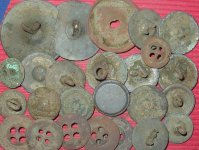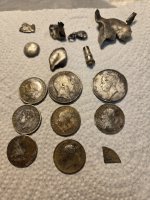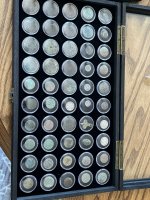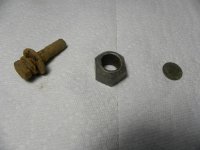I am wondering if anyone in TH has ever seen any record of spanish or Manillan ships sinking in the Sea of Cortez . Any one have references of ship routes of the Manilla ships . I have been a TH fan since I used to see Mel Fisher go out of Sebastion Inlet in the 1950's. Amazing how close the shipwrecks were to beach. Heres one to Mel .
You are using an out of date browser. It may not display this or other websites correctly.
You should upgrade or use an alternative browser.
You should upgrade or use an alternative browser.
shipwrecks in Sea of Cortez
- Thread starter bronc88
- Start date
- Oct 26, 2004
- 24,145
- 22,976
- 🏆 Honorable Mentions:
- 2
- Detector(s) used
- Minelab Explorer
- Primary Interest:
- Shipwrecks
Bronc:
Re: Galleon sea route
Sources:
http://en.wikipedia.org/wiki/Manila_Galleon
http://www.openwaters.biz/page/history/manila_galleons.html
Re: Baja and galleons:
Cabo San Lucas was an obligatory stop for the returning Manila galleons, loaded with all types of goods from China and the Moluccas: spices, silk, tea, sandalwood, ivory and candies, those small pieces of sugar that made everybody happy.
Source:http://www.expeditions.com/SiteSearch106.asp?keywords=cerda
Re: Galleon sea route
Sources:
http://en.wikipedia.org/wiki/Manila_Galleon
http://www.openwaters.biz/page/history/manila_galleons.html
Re: Baja and galleons:
Cabo San Lucas was an obligatory stop for the returning Manila galleons, loaded with all types of goods from China and the Moluccas: spices, silk, tea, sandalwood, ivory and candies, those small pieces of sugar that made everybody happy.
Source:http://www.expeditions.com/SiteSearch106.asp?keywords=cerda
I don't like to disgree with such a well-informed person as Don, but I am not sure that the Manila Galleons used Cabo as a stopping place. If anything, the area was used by pirates preying on the Spanish galleons, the most famous example being Thomas Cavendish, who captured the Santa Ana there in 1587.
Because Baja California and the Sea of Cortes had been discovered by Ulloa/Cortes well before the Manila Galleon trade began and there were no developed facilities there, there would be no reason for the Galleons to deliberately go up into the Gulf, so I would be surprised if there were any wrecks of them in that area. I don't think that the natural winds and currents would take a crippled ship that way, either, off the top of my head.
Mariner
Because Baja California and the Sea of Cortes had been discovered by Ulloa/Cortes well before the Manila Galleon trade began and there were no developed facilities there, there would be no reason for the Galleons to deliberately go up into the Gulf, so I would be surprised if there were any wrecks of them in that area. I don't think that the natural winds and currents would take a crippled ship that way, either, off the top of my head.
Mariner
- Oct 26, 2004
- 24,145
- 22,976
- 🏆 Honorable Mentions:
- 2
- Detector(s) used
- Minelab Explorer
- Primary Interest:
- Shipwrecks
Mariner:
As you have seen, most of my entries are sourced. Here are three in support of what I wrote earlier:
"Meanwhile, the Los Cabos area became an important stopover for the so-called Manila galleons - boats loaded with silk, perfumes and other treasure traveling from Acapulco to the Philippines. Their presence attracted numerous English pirates, most famously Thomas Cavendish, who sacked the prized Spanish galleon Santa Ana in 1587".
http://www.lonelyplanet.com/worldguide/mexico/cabo-san-lucas/history
"Formerly a supply station for Spanish treasure galleons, Cabo San Lucas was an ideal spot for pirates".
http://209.85.173.104/search?q=cach...s+Galleons&hl=en&ct=clnk&cd=30&gl=us&ie=UTF-8
Page 234 scroll to near bottom: http://books.google.com/books?id=4R...&hl=en&sa=X&oi=book_result&resnum=6&ct=result
Don.........
As you have seen, most of my entries are sourced. Here are three in support of what I wrote earlier:
"Meanwhile, the Los Cabos area became an important stopover for the so-called Manila galleons - boats loaded with silk, perfumes and other treasure traveling from Acapulco to the Philippines. Their presence attracted numerous English pirates, most famously Thomas Cavendish, who sacked the prized Spanish galleon Santa Ana in 1587".
http://www.lonelyplanet.com/worldguide/mexico/cabo-san-lucas/history
"Formerly a supply station for Spanish treasure galleons, Cabo San Lucas was an ideal spot for pirates".
http://209.85.173.104/search?q=cach...s+Galleons&hl=en&ct=clnk&cd=30&gl=us&ie=UTF-8
Page 234 scroll to near bottom: http://books.google.com/books?id=4R...&hl=en&sa=X&oi=book_result&resnum=6&ct=result
Don.........
- Oct 26, 2004
- 24,145
- 22,976
- 🏆 Honorable Mentions:
- 2
- Detector(s) used
- Minelab Explorer
- Primary Interest:
- Shipwrecks
Mariner:
We are on the same course: To seek greater knowledge and the rewards that we can derive from that knowldege.
Best,
Don....
We are on the same course: To seek greater knowledge and the rewards that we can derive from that knowldege.
Best,
Don....
- Thread starter
- #8
Good info so far. Mostly I was just trying to establish that there was a sufficient amount of traffic from that era. I suppose there were not as many hurricanes in the day , but certainly had to be threating storms at some time. In my mind if I was captain of a ship and I was cruising by the Sea of Cortez , I would look at it like "any port in a storm". No ducumented evidence of this I doubt.
But I always go back in my mind to my favorite fishing spot, Sebastian Inlet. That is where Mel Fischer found his first ships of the 1715 fleet. Apparently they were making an effort to get into that inlet. They did not make it of course, lucky for Mel .
Anyway, it is established that there was a fair amount of shipping in the vicinity.
Thanks again for the info.
Olin
But I always go back in my mind to my favorite fishing spot, Sebastian Inlet. That is where Mel Fischer found his first ships of the 1715 fleet. Apparently they were making an effort to get into that inlet. They did not make it of course, lucky for Mel .
Anyway, it is established that there was a fair amount of shipping in the vicinity.
Thanks again for the info.
Olin
Real de Tayopa Tropical Tramp
Gold Member
Good evening Bronc:
Yes there are many, including many treasure ships carrying the various mine's production south to Acalpulco. I can fill you in on this if you wish.
They sailed up the Mar de Cortez to the various mining shipping points.
There was probably more actual piracy on the west coast of Mexico than in most of the Caribean. These treasure ships were smaller and far less heavily armed than the Galleons, relatively easy pickings.
Incidentally Hurricanes were just as frequent and probably a bit more violent.
Don Jose de La Mancha
Yes there are many, including many treasure ships carrying the various mine's production south to Acalpulco. I can fill you in on this if you wish.
They sailed up the Mar de Cortez to the various mining shipping points.
There was probably more actual piracy on the west coast of Mexico than in most of the Caribean. These treasure ships were smaller and far less heavily armed than the Galleons, relatively easy pickings.
Incidentally Hurricanes were just as frequent and probably a bit more violent.
Don Jose de La Mancha
allen_idaho
Hero Member
I have never heard of a galleon sinking in the sea of cortez. The only thing close would be the legend of the spanish ship sank in the salton sea. Supposedly a spanish ship sailed up the sea of cortez into the lake. However, when they turned to leave, the found themselves trapped inside.
The only ships I know about near the sea of cortez are actually on the other side of baja on the south end. But they are more modern.
The Golden City - American paddle steamer sunk feb 22, 1870 off cape san lazaro. It carried gold valued at $791,000 but was salvaged at the time of loss.
The Continental - American ship sunk oct 26,1870 near cape san lucas. It carried specie valued at $140,000 and as far as I know has never been salvaged.
The Columbia - America ship sunk sept 31,1931 at point tosca, santa margarita island. It carried $700,000 in silver bars. $600,000 was recovered.
The only ships I know about near the sea of cortez are actually on the other side of baja on the south end. But they are more modern.
The Golden City - American paddle steamer sunk feb 22, 1870 off cape san lazaro. It carried gold valued at $791,000 but was salvaged at the time of loss.
The Continental - American ship sunk oct 26,1870 near cape san lucas. It carried specie valued at $140,000 and as far as I know has never been salvaged.
The Columbia - America ship sunk sept 31,1931 at point tosca, santa margarita island. It carried $700,000 in silver bars. $600,000 was recovered.
mad4wrecks
Bronze Member
- Dec 20, 2004
- 2,263
- 107
- Detector(s) used
- Aquapulse, DetectorPro Headhunter, Fisher F75
- Primary Interest:
- Shipwrecks
Here is a very good link to information about the Manilla galleons.
http://home.windstream.net/cr33856/
http://home.windstream.net/cr33856/
Real de Tayopa Tropical Tramp
Gold Member
HI: I repeat, check the mined metal supply / transport ships of smaller sizes. they could more easily enter many small side ports to collect the smelted mine bars for transport to Acapulco.
These were what actually attracted the pirates to the Pacific, not the heavily armed Manilla Galleons. Also many actually carried more values in smelted Gold and Silver than than the Manila Galleons.
I know of the general location of one that had just been loaded by lighters, then as it left, with full sail, it was hit by a squall and capsized in plain view of the people still on the shore. no survivors. State of Sonora.
Don Jose de la Mancha
These were what actually attracted the pirates to the Pacific, not the heavily armed Manilla Galleons. Also many actually carried more values in smelted Gold and Silver than than the Manila Galleons.
I know of the general location of one that had just been loaded by lighters, then as it left, with full sail, it was hit by a squall and capsized in plain view of the people still on the shore. no survivors. State of Sonora.
Don Jose de la Mancha
Real de Tayopa Tropical Tramp
Gold Member
HI again: I might mention that far more precious metal was moved by ship i
on the 'West Coast of Mexico than even sailed upon the caribean waters, and was less protected..
Don Jose de La Mancha
on the 'West Coast of Mexico than even sailed upon the caribean waters, and was less protected..
Don Jose de La Mancha
Don Jose,
In addition to the legal movement of silver along the Mexican coast, there was also a black market in silver from Mexico and Peru that was used to purchase goods arriving on the Manila Galleons, but not on the official manifest. The headquarters of this trade in the late 16th century was what is now called Santa Cruz de Huatulco, referred to by Drake and Cavendish as Guatulco.
A ship carrying a cargo of silver bars from Callao, the port of Lima, arrived at Huatulco just two days before Cavendish got there in 1589. Cavendish looted the town, including the official customs house, but found very little. As he left, he took the pilot off the ship that was still in the harbor. Two days later, he came back, rounded up the customs officer, and took a party of men to his private residence, some two miles inland. There he found, removed and took with him, what the official account cutely describes as "two chambers of stuffe".
The "stuffe" then went missing, along with one of Cavendish's ships, the Content, after Cavendish had captured and plundered the Manila Galleon "Santa Ana" off Cabo San Lucas. I believe that the Content ended up being wrecked on the Oregon coast, where somebody came across it and removed the silver in the 1930s.
Mariner
In addition to the legal movement of silver along the Mexican coast, there was also a black market in silver from Mexico and Peru that was used to purchase goods arriving on the Manila Galleons, but not on the official manifest. The headquarters of this trade in the late 16th century was what is now called Santa Cruz de Huatulco, referred to by Drake and Cavendish as Guatulco.
A ship carrying a cargo of silver bars from Callao, the port of Lima, arrived at Huatulco just two days before Cavendish got there in 1589. Cavendish looted the town, including the official customs house, but found very little. As he left, he took the pilot off the ship that was still in the harbor. Two days later, he came back, rounded up the customs officer, and took a party of men to his private residence, some two miles inland. There he found, removed and took with him, what the official account cutely describes as "two chambers of stuffe".
The "stuffe" then went missing, along with one of Cavendish's ships, the Content, after Cavendish had captured and plundered the Manila Galleon "Santa Ana" off Cabo San Lucas. I believe that the Content ended up being wrecked on the Oregon coast, where somebody came across it and removed the silver in the 1930s.
Mariner
- Oct 26, 2004
- 24,145
- 22,976
- 🏆 Honorable Mentions:
- 2
- Detector(s) used
- Minelab Explorer
- Primary Interest:
- Shipwrecks
FWIW: Just read another source noting Manila galleons at Cabo San Lucas: Comments by Derke Howse and Norman Thrower in their book highlighting "A Buccaneer's Atlas"-- Basil Ringrose's South Sea Waggoner where, on page 59 the authors state: "Cavo de Lucas= Cabo San Lucas. The departure point for the Acapulco-bound Manila galleon."
Don......
Source: As above (ISBN 0-520-05410-5; The University of California Press, Berkeley--1992).
Don......
Source: As above (ISBN 0-520-05410-5; The University of California Press, Berkeley--1992).
Real de Tayopa Tropical Tramp
Gold Member
Geeze Mariner, where were we in 1930 when the galleon was salvaged, sigh. Nice post.
Mackaydon excellent as usual, when are we going to go for the Zimmerman Gold?
Don Jose de La Mancha
Mackaydon excellent as usual, when are we going to go for the Zimmerman Gold?
Don Jose de La Mancha
mdthomas321
Newbie
- Apr 12, 2012
- 2
- 8
- Primary Interest:
- All Treasure Hunting
I have never heard of a galleon sinking in the sea of cortez. The only thing close would be the legend of the spanish ship sank in the salton sea. Supposedly a spanish ship sailed up the sea of cortez into the lake. However, when they turned to leave, the found themselves trapped inside.
The only ships I know about near the sea of cortez are actually on the other side of baja on the south end. But they are more modern.
The Golden City - American paddle steamer sunk feb 22, 1870 off cape san lazaro. It carried gold valued at $791,000 but was salvaged at the time of loss.
The Continental - American ship sunk oct 26,1870 near cape san lucas. It carried specie valued at $140,000 and as far as I know has never been salvaged.
The Columbia - America ship sunk sept 31,1931 at point tosca, santa margarita island. It carried $700,000 in silver bars. $600,000 was recovered.
Hi there,
I was wondering where I could find more information on The Continental, and other ships you mentioned in your post above?
Thanks Much!
S
stefen
Guest
The Lost Pearl Ship located in the southern California desert (El Centro) was formerly a part of the Sea of Cortez
http://en.wikipedia.org/wiki/Lost_Ship_of_the_Desert
http://en.wikipedia.org/wiki/Lost_Ship_of_the_Desert
Last edited:
allen_idaho
Hero Member
Hi there,
I was wondering where I could find more information on The Continental, and other ships you mentioned in your post above?
Thanks Much!
The best thing to do would be to search newspaper archives. But I will transcribe on article about the wreck here:
New York Times - October 15, 1870
SAN FRANCISCO, Oct. 14 - The steam-ship Colorado, from Panama, put into San Diego this morning and reports that the steam-ship Continental, from Mazatlan, Mexico, for San Francisco, foundered at sea, thirty miles off Cape St. Lucas, on the 30th of September. Seven of the passengers and one of the crew were lost.
ADDITONAL DETAILS
SAN FRANCISCO, Cal., Oct. 14 - The steamer Continental left Mazatlan with a full complement of passengers, $140,000 in treasure, 700 tons of salt, and a large mail. On the 28th of September, she encountered a severe gale in the Gulf and sprung a leak. The pumps were worked constantly for twelve hours, but to no avail. At 9 o'clock on the morning of the 29th the water reached the furnaces, putting out the fires. All hopes of saving the vessel were then abandoned, and six boats, filled with people, shoved off. Seven passengers and the second cook refused to leave the steamer, and went down with her. Two of the boats arrived at Cape St. Lucas on the evening of the 30th. The other boats landed near Cape St. Lucas.
The following is a list of the lost: Manuel Rubio, Mazatlan ; Jose Monas, San Luis Potosi ; J.B. Lytle, M. Martinez, and three Mexicans, names unknown. The escaped passengers and a portion of the crew are on board the steamer Colorado, and expected here on Sunday next. The others of the crew are on the gun-boat Ossippee. The Continental's treasure and mails are a total loss.
- Jun 3, 2007
- 1,191
- 2,000
- Detector(s) used
- A sharp eye, an AquaPulse and a finely tuned shrimp fork.
- Primary Interest:
- Shipwrecks
Good info so far. Mostly I was just trying to establish that there was a sufficient amount of traffic from that era. I suppose there were not as many hurricanes in the day , but certainly had to be threating storms at some time. In my mind if I was captain of a ship and I was cruising by the Sea of Cortez , I would look at it like "any port in a storm". No ducumented evidence of this I doubt.
But I always go back in my mind to my favorite fishing spot, Sebastian Inlet. That is where Mel Fischer found his first ships of the 1715 fleet. Apparently they were making an effort to get into that inlet. They did not make it of course, lucky for Mel .
Anyway, it is established that there was a fair amount of shipping in the vicinity.
Thanks again for the info.
Olin
Remember that things change over time from both natural processes and the hand of man. The Sebastian Inlet is a man made cut. The present Sebastian Inlet was cut around 1924 according to Sebastian Inlet District - The History of Sebastian Inlet, Florida . Another interesting history of the Inlet is at Sebastian Inlet - Wikipedia, the free encyclopedia .
It has always been my understanding that the 1715 Fleet was driven ashore despite their desperate attempts to stay far offshore in the Gulf Stream.
Users who are viewing this thread
Total: 2 (members: 0, guests: 2)







